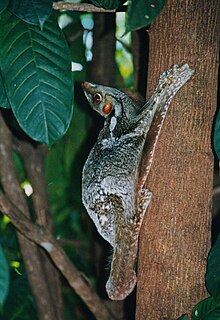Malayan flying lemur
| Sunda flying lemur | |
|---|---|
 |
|
| Galeopterus variegatus | |
| Scientific classification | |
| Kingdom: | Animalia |
| Phylum: | Chordata |
| Class: | Mammalia |
| Order: | Dermoptera |
| Family: | Cynocephalidae |
| Genus: |
Galeopterus Thomas, 1908 |
| Species: | G. variegatus |
| Binomial name | |
|
Galeopterus variegatus (Audebert, 1799) |
|
| Type species | |
|
Galeopitiecus temminckii Waterhouse, 1838 |
|
 |
|
| Sunda flying lemur range | |
Habits and lifestyle
Sunda flying lemurs live either solitary or in small groups that are loosely connected. They can be territorial as regards foraging and sleeping areas. They are mainly nocturnal. They are strictly arboreal and in the daytime they sleep high within dense foliage in the treetops or in holes in trees. With all four of their feet, they cling on to the trunk of a tree or the underside of branches. Climbing involves stretching out their two front legs and then bringing up their two back legs, which results in an awkward hopping. They can glide more than 100 m with minimal loss in elevation. When threatened they either climb higher up or remain motionless. These animals are quite helpless if on the forest floor. The Sunda flying lemur (Galeopterus variegatus), also known as the Malayan flying lemur, Sunda Colugo or Malayan colugo, is a species of colugo. Until recently, it was thought to be one of only two species of flying lemur, the other being the Philippine flying lemur which is found only in the Philippines. The Sunda flying lemur is found throughout Southeast Asia in Indonesia, Thailand, Malaysia, and Singapore.
The Sunda flying lemur is not a lemur and does not fly. Instead, it glides as it leaps among trees. It is strictly arboreal, is active at night, and feeds on soft plant parts such as young leaves, shoots, flowers, and fruits. After a 60-day gestation period, a single offspring is carried on the mother's abdomen held by a large skin membrane. It is a forest-dependent species.
The head-body length of Sunda flying lemur is about 33 to 42 cm (13 to 17 in). Its tail length measures 18 to 27 cm (7.1 to 10.6 in), and its weight is 0.9 to 1.3 kg (2.0 to 2.9 lb).
The Sunda flying lemur is protected by national legislation. In addition to deforestation and loss of habitat, local subsistence hunting poses a serious threat to this animal. Competition with the plantain squirrel (Callosciurus notatus) represents another challenge for this species. More information is needed on population declines, but at present, the rate of the decline is not believed to merit listing in any category lower than Least Concern.
...
Wikipedia

